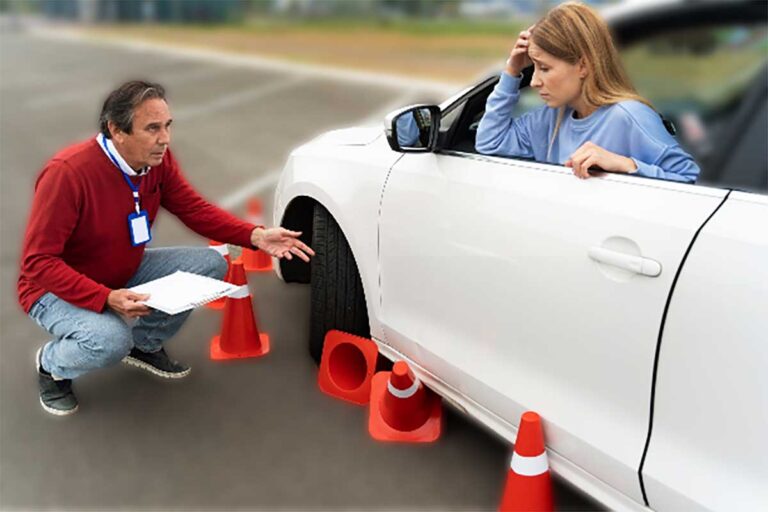Top Safe Driving Tips for Atlanta Motorists
As a motorist in Atlanta, it is crucial to be ready for unforeseen circumstances. Driving in Atlanta requires not just skills but also a proactive mindset. The city’s notorious traffic and complex road systems make it imperative for drivers to adopt robust defensive driving techniques. Whether you’re navigating through peak rush hour or tackling the infamous Spaghetti Junction, it is important to adhere to safe driving at all times. This guide will provide you with practical defensive driving strategies specifically designed for Atlanta’s distinctive driving landscape.
Key Insights
- Mastering defensive driving in Atlanta involves understanding local traffic dynamics, ensuring safety at intersections, and managing highway challenges to prevent accidents.
- Developing advanced defensive driving skills is crucial, focusing on anticipating others’ actions, adapting to weather changes, and maintaining your vehicle.
- Initiatives from the Georgia Department of Transportation, such as the ‘Drive Alert, Arrive Alive’ campaign and the Hands-Free Georgia Act, play a significant role in promoting safer driving in the city.
Injured In A Car Wreck? Contact Us For A Free Consultation
Injured In A Car Wreck?

Mastering Defensive Driving Techniques in Atlanta
Defensive or safe driving is more than a skill; it’s an essential approach that combines awareness, preparation, and strategic thinking. Every decision made while driving—from route selection to response to aggressive behavior—contributes to overall safety. Understanding the unique characteristics of Atlanta’s traffic and driving conditions is vital for any motorist looking to enhance their driving confidence.
Grasping Atlanta’s Traffic Dynamics
Traffic patterns in Atlanta resemble a complex web, with specific peak times that every driver should be aware of. Effectively planning your route and remaining vigilant to potential hazards becomes more manageable when you identify specific rush hour periods through a traffic application. So, when do these peak hours occur? In Atlanta, the most congested traffic times generally fall between 6 AM and 9 AM, with another surge in the evening from 3:30 PM to as late as 7:30 PM. By steering clear of these peak hours, you can enhance your safety as a driver and minimize the likelihood of accidents.
However, it is not solely about the timing of your drive; the location also plays a crucial role. Certain regions in Atlanta are infamous for their traffic congestion. Below are some of the most frequently congested areas:
- I-285 East at I-85/Exit 33 in DeKalb County
- I-85 South at I-75/I-85/Exit 85 in downtown Atlanta
- I-285 South at I-20/Exit 10 in Fulton County
- The infamous Spaghetti Junction
Having a comprehensive understanding of these traffic hotspots allows you to plan your journeys more effectively.
Intersection Safe Driving Tips
Intersections serve as vital junctures where multiple roadways meet, frequently becoming locations prone to a high incidence of accidents. Whether navigating a four-way stop or a more intricate intersection equipped with traffic signals, it is essential to proceed with vigilance. In Atlanta, you can enhance intersection safety by:
- Always checking for pedestrians
- Approaching left turns carefully
- Refraining from excessive speed
- Maintaining a safe following distance
- Preparing to stop at yellow lights
- Obeying all traffic laws
However, compliance with traffic laws is only part of the equation; situational awareness is equally important. Awareness is key; remember that pedestrians outside marked crosswalks must yield to vehicles unless they have already entered the roadway. Prioritizing safety and minimizing distractions can dramatically improve your experience at intersections. By consciously adopting these practices and following traffic laws, you can take charge of your driving experience and contribute to making Atlanta’s intersections safer for everyone.
Highway Navigation
Highway driving presents unique challenges, especially in a city like Atlanta, where speed limits are higher and traffic can be unpredictable. The high speeds, frequent construction zones, and instances of road rage can render the experience quite intimidating. However, as a defensive driver, you possess the ability to navigate the highways of Atlanta effectively. The primary highways in Atlanta include:
- Interstates 20
- 75
- 85
- Georgia 400
- I-285
It is important to note that I-285 is regarded as one of the most hazardous highways in the country, necessitating heightened vigilance.
Beyond the challenges, there are also opportunities for personal development. By adhering to the following guidelines, you can enhance your skills in defensive driving on Atlanta’s highways. To navigate these roads safely:
- Conduct a pre-drive vehicle check
- Always wear your seatbelt
- Stay aware of blind spots
- Exercise caution during merges
- Avoid exit-only far-right lanes
The key lies in maintaining focus, being observant, and prioritizing safety while driving.

GEORGIA PERSONAL INJURY LAWYER NEAR ME
Improving Your Defensive Driving Skills
Having acquired a solid foundation in defensive driving in Atlanta, you are now poised to elevate your skills further. Enhancing your defensive driving abilities will better equip you for the challenges of the road and facilitate more effective responses to unforeseen circumstances. This includes predicting the behavior of other drivers, adapting to challenging weather conditions, and ensuring regular vehicle maintenance.
The ability to anticipate the actions of other drivers can significantly enhance your defensive driving proficiency. A safer driving experience and the prevention of potential collisions stem from keenly observing other drivers for cues that suggest their next maneuvers, adhering to speed regulations, and remaining vigilant at all times. However, what strategies should you employ when faced with unfavorable weather conditions?
Anticipating the Actions of Other Drivers
On the bustling streets of Atlanta, every moment is crucial. Staying alert and observing your surroundings can significantly enhance your driving safety. Here’s how:
- Maintaining vigilance
- Being cognizant of your environment
- Observing the road ahead to foresee potential hazards
- Checking your mirrors frequently
- Scanning for possible lane changes
Utilizing these strategies can effectively minimize the chances of accidents and contribute to a more secure driving experience.
However, what should one do when a driver appears poised to run a red light? Some indicators to watch for include:
- Exhibiting aggressive driving patterns such as speeding and tailgating
- Failing to come to a complete stop before making a turn at a red light or disregarding stop signs
- Overlooking ‘No Turn on Red’ signage
- Tailgating the vehicle in front while approaching an intersection
By maintaining a proactive stance, you can better react to unforeseen situations.
Adjusting to Challenging Weather Conditions
Challenging weather conditions can significantly complicate driving. Whether faced with heavy rainfall, strong winds, or fog, it is essential to modify your driving practices to maintain safety. In rainy conditions, which are prevalent in Atlanta and can lead to some of the most hazardous driving scenarios in the nation, it is advisable to:
- Reduce speed to avoid hydroplaning
- Increase following distances
- Use headlights for better visibility
- Refrain from abrupt braking or acceleration
- Maintain focus and eliminate distractions
Adjusting your driving style to match weather conditions will help ensure a safer journey. By adhering to these recommendations, you can promote a safer driving experience during rainy weather.
Moreover, it is not solely about reducing speed. When navigating adverse weather, increasing your following distance allows for greater reaction time in the event of sudden stops. When visibility is compromised and road conditions are unfavorable, such as during heavy rain or fog, it becomes particularly vital that we take extra precautions. By adjusting your driving behavior to align with the prevailing conditions, you can safely traverse Atlanta’s roads, regardless of the weather.
Proper Vehicle Maintenance Practices
Regular vehicle maintenance is non-negotiable for safe driving. Your vehicle serves as an essential companion during your travels, and, akin to any successful partnership, it necessitates diligent care and attention. Regular maintenance of your vehicle is vital for ensuring safe driving and averting unforeseen breakdowns. By maintaining your car in optimal condition, you significantly reduce the likelihood of malfunctions or breakdowns that could endanger you on the road.
So, how frequently should you undertake standard vehicle maintenance tasks to ensure safe driving? Adhering to your vehicle’s maintenance schedule—typically at intervals of 30,000, 60,000, and 90,000 miles—can prevent mechanical failures and enhance overall safety. Furthermore, you should perform fundamental maintenance activities such as fluid checks and changes every three months or 3,000 miles, six months or 5,000 miles, and annually or 10,000 miles.

Georgia Department of Transportation (GDOT) Initiatives
The Georgia Department of Transportation (GDOT) actively promotes safe driving practices. GDOT dedicates itself to enhancing road safety for all Georgia residents through initiatives like the Drive Alert, Arrive Alive campaign and the Hands-Free Georgia Act.
Drive Alert, Arrive Alive Campaign
This campaign encourages drivers to adopt simple yet effective changes to their behavior, aiming to reduce accidents and improve road safety. The Drive Alert, Arrive Alive initiative, spearheaded by the Georgia Department of Transportation (GDOT), seeks to foster a culture of safer and more responsible driving for all road users. This initiative empowers motorists to implement straightforward modifications in their driving practices to:
- Prevent collisions
- Reduce accidents
- Enhance safety
- Save lives
Aimed at advocating for safer driving behaviors and ensuring work zone safety, the initiative concentrates on decreasing the incidence of traffic accidents and elevating overall travel safety on roadways, ultimately striving to save lives. This campaign represents a significant collaboration among the Georgia Department of Transportation (GDOT), the Governor’s Office of Highway Safety, and the National Safety Council, motivating drivers to adopt minor chansges in their driving habits to improve road safety.
Hands-Free Georgia Act
Implemented to combat distracted driving, this legislation prohibits drivers from holding their phones while driving. It has successfully reduced the percentage of traffic deaths linked to distracted driving, showcasing the importance of focused driving.
The Hands-Free Georgia Act represents a crucial legislative measure that has significantly influenced driving practices and reduced accident rates within the state. Enacted in 2018, this law has contributed to a notable decrease in incidents related to distracted driving. Specifically, the proportion of traffic fatalities attributed to distracted drivers fell from 5.3% in 2017 to 3.1% in 2021, highlighting the Act’s beneficial impact.
What are the key provisions of this Act?
The Hands-Free Georgia Act prohibits drivers from holding a mobile phone or using any part of their body to support it while operating a vehicle. Nevertheless, it permits the use of voice-to-text technology for sending messages and making hands-free calls through headsets or earpieces. Drivers are allowed to use GPS devices if mounted on the dashboard or windshield.
Compliance with the Hands-Free Georgia Act not only helps individuals avoid penalties and points on their driving records but also plays a vital role in enhancing road safety throughout Georgia.

The Value of Defensive Driving Courses in Atlanta
Defensive driving courses extend beyond merely understanding traffic regulations. They focus on providing individuals with the necessary skills and insights to foresee possible hazards and respond effectively. In Atlanta, these courses deliver essential training on safe driving techniques, which may include advantages such as reductions in insurance premiums and the possibility of point deductions on driving records.
Where can one enroll in these courses, and what do they entail? Let us explore the details of defensive driving courses available in Atlanta and their potential to improve your driving proficiency.
Course Offerings and Locations
Defensive driving courses serve as an effective means to enhance your driving abilities and increase safety on the road. These programs encompass a variety of subjects, such as:
- Comprehending traffic regulations
- Predicting the actions of other drivers
- Minimizing distractions
- Navigating challenging weather conditions
- Steering clear of aggressive driving tendencies
Notable defensive driving institutions include ACT Driving Schools and Atlanta Area Driving & DUI School. Enrolling in a defensive driving course can significantly elevate your confidence and proficiency as a driver.
Moreover, these courses provide remarkable flexibility. Whether you opt for an in-person session at venues like A-1 Driving Schools or choose an online program from DriveSafeToday or Georgia Driving School, there is a suitable option to accommodate your timetable. Additionally, the average fee for a defensive driving course in Atlanta is approximately $95, a modest investment for the enhanced skills and reassurance you will acquire.
Benefits of Completing a Defensive Driving Course
Participating in a defensive driving course provides advantages beyond enhancing driving abilities. Upon successful completion, individuals may qualify for insurance discounts and a reduction of points on their driving record. By engaging in such a course, one can access an appealing insurance discount that ranges from 5% to 20%.
Moreover, the benefits extend beyond mere discounts. In Georgia, completing a defensive driving course confers the following advantages:
- Insurance discounts of 5% to 20%
- Removal of up to 7 points from your driving record (once every five years)
- Lower insurance premiums
Investing in these courses is a wise choice for any Atlanta driver.

Need a Free Consultation? Need a Skilled Attorney?
Free Consultation
Call (770) 771-5130
If you’ve been injured, you need to hire the best legal care to assist you with your claim. Get a FREE consultation today!
Sharing the Road Responsibly
Operating a vehicle extends beyond individual concerns; it encompasses the obligation to share the roadway with fellow users, which includes other drivers. Whether it involves a motorcycle swiftly passing or a pedestrian navigating a crosswalk, maintaining awareness of others on the road is an essential component of defensive driving.
This section will emphasize the importance of safely sharing the road with motorcyclists, cyclists, and pedestrians.
Motorcycle Safety
Motorcycles can often be difficult to detect on the road due to their smaller dimensions in comparison to other vehicles, necessitating heightened awareness from drivers. To ensure the safety of all road users, it is essential to provide motorcyclists with sufficient space, consistently check mirrors and blind spots, and remain cognizant of their ability to maneuver.
However, sharing the road with motorcycles involves more than mere caution; it also requires comprehension of the regulations. In Georgia, legislation mandates that drivers must safely coexist with motorcyclists. In Georgia, motorcycles are not allowed to navigate between lanes of slow-moving or halted traffic through lane splitting. By familiarizing ourselves with and adhering to these regulations, we can collectively foster a safer roadway for everyone.
Bicycle and Pedestrian Safety Awareness
Similar to motorcycles, bicycles and pedestrians share the roadway with motor vehicles. In Atlanta, bicycles are classified as vehicles and must adhere to the same traffic regulations. Cyclists must ride in the same direction as traffic when using a bicycle lane. If a path is designated solely for bicycles, they are required to use it instead of the sidewalk.
Motorists have a significant responsibility in promoting the safety of both cyclists and pedestrians on the road. Below are several measures that drivers can take to foster a safer environment for all road users:
- Keep a minimum distance of three feet when passing a bicycle
- Stay vigilant for cyclists when executing turns or changing lanes
- Give priority to pedestrians at crosswalks and intersections
- Adhere to all traffic laws and signals

GEORGIA PERSONAL INJURY LAWYER NEAR ME
Navigate Georgia Roads with Confidence
Driving in Atlanta presents challenges, but with the right knowledge and techniques, you can navigate its roads with confidence. By mastering traffic dynamics, enhancing intersection safety, and being proactive about vehicle maintenance and weather conditions, you can significantly improve your driving safety. Defensive driving is not merely about following rules; it’s about taking initiative, remaining alert, and making informed decisions. Together, we can contribute to safer roads across Atlanta, one driver at a time.
Frequently Asked Questions
What are five strategies for defensive driving?
Driving defensively requires several key practices:
- Getting to know your route
- Staying attentive to road conditions
- Applying the brakes in advance
- Maintaining a safe following distance
- Being ready for the unexpected
Prioritizing safety is crucial; remain aware of your surroundings while driving. It is important to avoid relying on the actions of other drivers, maintain adequate space between vehicles, and always have an escape plan in mind to minimize risks on the road. Additionally, eliminate distractions and reduce your speed to promote a safer driving experience.
How often can you enroll in defensive driving courses in Georgia?
In Georgia, individuals may take the six-hour defensive driving course every five years to potentially reduce up to seven points from their driving record. This opportunity can aid in preserving a clean record and may lead to decreased insurance premiums.
What is the fundamental principle of defensive driving?
The core principle of defensive driving revolves around "aiming high," which entails remaining vigilant and focused to prevent accidents and alert other motorists about possible traffic dangers. Keeping your gaze elevated ensures a comprehensive view of the roadway.
What are the three essential steps in a defensive driving strategy?
A successful defensive driving approach encompasses three primary steps: Prepare, Anticipate, and Defend. These elements serve as guidelines for navigating any driving environment safely.
What critical skills should be developed for effective defensive driving in Atlanta?
To effectively master defensive driving skills in Atlanta, it is vital to comprehend local traffic patterns, practice safety at intersections, and build confidence when navigating highways. Drive safely!





